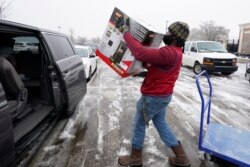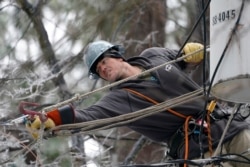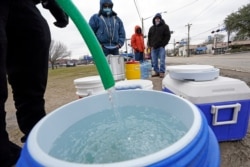As a series of winter storms cut across Texas and the American South, residents are left trying to survive an ill-prepared infrastructure system.
“I have electricity at the moment, but I don’t know how long it’s going to last,” said Cecily Jones, a resident of Katy, Texas, a suburb 48 kilometers west of Houston.
Jones is one of about 4 million people in the U.S. state of Texas — and hundreds of thousands more in southern states such as Louisiana, Mississippi, Oklahoma, Kentucky, West Virginia and Virginia — whose homes lost power this week because of prolonged periods of unusually cold weather in the region.
She said the Electric Reliability Council of Texas (ERCOT), which oversees the state’s power grid, has only managed to supply electricity to her home for about six hours each day. With temperatures as low as minus 8 degrees Celsius sweeping across the area, that leaves it extremely cold inside her house.
But heat is just one of several problems Jones said she is facing.
“I haven’t had water for days,” Jones said. “The pipe busted when it froze and flooded nearly my entire home, except for the bedrooms on the other side of the house. If I wasn’t there to shut the water off, my ceiling would have collapsed.”
With millions of other residents in the region struggling through the same storm, Jones said she has been unable to reach the insurance company, or even a plumber.
Instead, she is stuck in her house with few options. The roads are too icy to travel on, so she cannot get supplies. The icy roads also make it impossible to reunite with her daughter, who is staying with Jones’ parents. And even if she could reach an area hotel, all its rooms are booked.
“Do I even want to stay in a hotel?” she asked. “The coronavirus pandemic didn’t just magically disappear because of this storm. But how long can I stay here without electricity and water? I’m just trying to hold on a day at a time.”
The White House said in a statement Thursday that President Joe Biden had a conversation with Greg Abbot, the governor of hard-hit Texas.
The statement said the president told Abbott “that the federal government will continue to work hand-in-hand with state and local authorities in Texas to bring relief and address the critical needs of the families affected.”
“The president also expressed that his administration was at the ready should the state of Texas or any other impacted region need additional federal disaster support or assistance as severe storms move across the U.S.,” the statement said.
30-year storm
More than 71% of the contiguous United States is covered in snow, as Texas and neighboring Louisiana are being hit by some of the coldest temperatures they have experienced in 30 years.
The average February temperature in Texas is about 13 degrees Celsius. The current cold front formed last weekend is bringing in temperatures far below normal and is wreaking havoc on the state’s ill-prepared infrastructure.
About 7 million residents in the Houston and Dallas-Fort Worth areas alone have been ordered to boil their water because power outages and frozen lines have made the water unsafe to drink. Many of those residents, like Jones, cannot access water to boil because the pipes in their homes ruptured when frozen.
Kimberly Malloy is sheltering in San Antonio, Texas, with her boyfriend and two sons in a house that has not had water for several days.
“We’ve resorted to gathering snow and melting it down for drinking, bathing and flushing the toilet,” she said. “Who knows when we’ll get plumbing back?”
But Malloy also acknowledged she is one of the luckier ones. About 30 Americans have died across the southern United States this week directly and indirectly related to the weather, and many more are fighting for their lives.
“There are people stranded with their cars on the side of impassable roads with no blankets or food to eat,” she said. “And there are homeless people who have no food, no shelter, no water, and are freezing. My situation isn’t nearly as bad.”
One woman, Tabitha Amerson, who lives 45 minutes west of Houston, told VOA how a combination of power outages and undriveable roads nearly killed her neighbor’s child.
“He’s on a ventilator that needs electricity so he can breathe,” she said.
When her town lost power, the family had to manually keep him breathing while they waited for an ambulance to arrive. The ambulance was delayed because of snow and ice and a high volume of emergencies resulting from the storm.
“And then they had to try several hospitals before they could find him a room, because most of them were filled,” Amerson said. “Thank goodness he made it, but there are quite a few people who haven’t been so lucky.”
Who is accountable?
Kendall Torres lives on the southern outskirts of Austin. She still has electricity — likely, she thinks, because her apartment is situated between two hospitals. But she hasn’t had water for 40 hours.
She is currently caring for her neighbor’s dogs, which she had to rescue because the storm stranded the neighbor at a friend’s house. She is also hosting her sister, whose downtown Austin apartment building had water coming through the ceilings, out of the elevator shafts and into the halls when its pipes burst Monday night.
Torres is relieved to be able to help, and she braved icy roads to deliver supplies and jackets to a nearby homeless camp. But she is angry.
“This is so frustrating and needless,” she said. “It didn’t have to get this bad. We knew severe weather was coming, so why wasn’t the infrastructure prepared?”
The answer, Torres believes, is years of bad policies, deregulation and ignoring the warning signs that led to this moment.
On Wednesday, Texas governor Abbott admitted that “every source of power the state of Texas has access to has been compromised because of the ultra-cold temperature or because of equipment failures.”
To many critics in the state, however, Abbott and many of his predecessors — as well as the regulators appointed by them to run ERCOT — have been too lax in requiring the power company to safeguard Texas’s electrical grid against increasingly volatile weather.
“The situation we’re in right now is because of climate change,” said Amanda Petro of Austin, whose water heaters burst, damaging her ceiling, walls and floors. “What’s happening now shouldn’t be a surprise — it’s been building slowly for a long time.”
Meg Lousteau, a resident of Houston who first lost power early Monday morning and still does not have water, also sees this as a failure of government.
“It’s tempting to call this a natural disaster, and that’s partially true,” she said. “But this is also a disaster because our government failed us by not planning properly.”
She believes energy providers like ERCOT should be required to keep enough energy in reserve for emergencies. When the temperature finally warms next week and the utilities begin to return to normal, Lousteau said, she plans to advocate to ensure something like this never happens again. In the meantime, she is just trying to hang on.
“It’s shocking here,” she said. “I tried to go to the grocery store, and it’s a 100-person, hourlong line in below-freezing weather before you can even get inside. It’s dangerous.”
Lousteau said she has spent several hours the last four days with her two foster dogs in her car charging her phone and trying to keep warm.
“But what about the many people in Houston who don’t have cars to warm up in?” she wondered. “It’s supposed to get cold again these next few days. What if the grid fails a second time? I’m worried we’re not through this yet.”

















